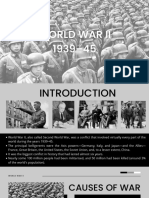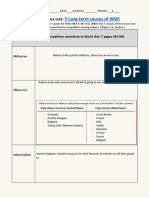0 ratings0% found this document useful (0 votes)
72 viewsWW2
Al Doilea Război Mondial a fost un război global care a durat din 1939 până în 1945, deși unele conflicte asociate lui au început și mai devreme. El a implicat marea majoritate a țărilor lumii—inclusiv toate marile puteri—care au format două alianțe militare opuse: Aliații și Axa. A fost cel mai întins război din istorie, și a implicat direct mai mult de 100 de milioane de oameni din peste 30 de țări. Cei mai importanți participanți și-au dedicat întreaga capabilitate economică, industrială și ș
Uploaded by
Vlad AlistarCopyright
© © All Rights Reserved
Available Formats
Download as PPTX, PDF, TXT or read online on Scribd
0 ratings0% found this document useful (0 votes)
72 viewsWW2
Al Doilea Război Mondial a fost un război global care a durat din 1939 până în 1945, deși unele conflicte asociate lui au început și mai devreme. El a implicat marea majoritate a țărilor lumii—inclusiv toate marile puteri—care au format două alianțe militare opuse: Aliații și Axa. A fost cel mai întins război din istorie, și a implicat direct mai mult de 100 de milioane de oameni din peste 30 de țări. Cei mai importanți participanți și-au dedicat întreaga capabilitate economică, industrială și ș
Uploaded by
Vlad AlistarCopyright
© © All Rights Reserved
Available Formats
Download as PPTX, PDF, TXT or read online on Scribd
You are on page 1/ 14
World War II was a global war that lasted from 1939 to 1945, although
some of its associated conflicts began earlier. It involved the vast
majority of the countries of the world, including all the great powers,
which formed two opposing military alliances: the Allies and the Axis. It
was the largest war in history, and directly involved more than 100
million people in over 30 countries. The most important participants
have devoted their entire economic, industrial and scientific capability
to war effort, in a state of "total warfare“, erasing the distinction
between civilian and military resources. Marked by the massive deaths
of civilians, including the Holocaust (in which about 11 million people
were killed) and the strategic bombings of industrial and demographic
centers (where about one million people died and within which they
were distinguished atomic bombing in Hiroshima and Nagasaki), it led to
between 50 and 85 million deaths, more than any other conflict in the
history of mankind.
. Causes of World War II
•the expansive policy of Germany and Italy, based on the two doctrines: Nazism
and Fascism.
•the revisionism of some states such as Germany, the USSR, Hungary. All of these
considered the Versailles System as dictated by the fact that the states that were
defeated in World War I did not have the right to challenge the provisions of the
Paris-Versailles Treaties System.
•the collective security system promoted by the League of Nations was a fragile
element in Europe because the Member States could not understand and could
not solve some land annexes such as the annexation by Italy of Ethiopia and
Abisina
•the establishment in 1936 of the Tripartite Pact (Axis), which aimed at
reconfiguring the global map and fighting communism.
•the division of Eastern Europe into two spheres of influence by signing the non-
aggression treaty between Germany and the USSR, called the Ribbentrop-
Molotov Pact (August 23, 1939), according to which Poland was divided, and a
secret annex mentioned that the USSR could annex Bessarabia and Northern
Bucovina without the interference of Germany.
World War II involved mainly two major military
alliances:
Powers of the Axis:
was a group of countries headed by Nazi Germany, the
Fascist Italy and the Japanese Empire. These three great
powers are considered the main aggressive forces in
the conflict.
Allies:
led by the United Kingdom and France (last to
surrender), increased their ranks with the Soviet Union
(after June 1941) and the United States of America
(after 1941). Among the Allies, on the Asia and Pacific
front, was the Republic of China, which has been in war
with Japan since 1937.
Progress of the war
-September 1, 1939: Nazi troops invade Poland.
-September 3, 1939: France and England declare war on Germany.
-April 9, 1940: Germany occupies North and West Europe, including France.
-June 22, 1941: Germany invades the Soviet Union, under the Barbarossa Operation,
with a strong resistance to Leningrad.
-December 7, 1941: Japan destroys the American fleet at Pearl Harbor, and US
President Franklin Delano Roosevelt decides to join the United States at war.
-January 20, 1942: The Wanssee conference near Berlin is taking place, where it is
decided that the "final solution" is the extermination of the Jews.
-February 2, 1943: The Soviet troops defeated Stalingrad, taking 100,000 German
prisoners.
-June 6, 1944: The Allies landed in Normandy, followed by intense battles
culminating in the liberation of Paris on August 25.
-28 and 30 April 1945: Mussolini is executed and Hitler suicides
-9 May,1945:The Soviet Union celebrates victory
Advantages of the war
Munitions: ships, vehicles, airplanes, missiles,artillery,
infantry weapons and atomic weapons
Military logistics:vehicles for the transport of soldiers
and equipment
Communications, espionage and counter-
intelligence:communications,equipment,
navigation, remote detection and espionage
Medicine:the development of surgical techniques, the
discovery of some drugs.
Disadvantages of the war
-Europe ruined:millions of refugees from all over Europe had
no home, the economy was in deep crisis, and much of the
industrial infrastructure of the continent was destroyed.
The Soviet Union was severely affected, with about a third
of its economy being destroyed.
-The balance of human losses:50-85 million dead and tens of
millions of people mutilated
-Experiments on humans, death by starvation, people
turned into soap, gas chambers and bearings and people
killed for "fun"
You might also like
- AJC JC2 H2 History Paper 1 Prelims 2017 Question PaperNo ratings yetAJC JC2 H2 History Paper 1 Prelims 2017 Question Paper6 pages
- World War II: World War II (WWII or WW2), Also Known As The Second World War, Was ANo ratings yetWorld War II: World War II (WWII or WW2), Also Known As The Second World War, Was A8 pages
- Brown Black Classic Painting Project History Presentation (1)No ratings yetBrown Black Classic Painting Project History Presentation (1)10 pages
- The Second World War", "WWII", and "WW2" Redirect Here. For Other Uses, See andNo ratings yetThe Second World War", "WWII", and "WW2" Redirect Here. For Other Uses, See and4 pages
- World War II: 1935: Italy Invades Abyssinia (Ethiopia) (Few Independent Problems in GermanyNo ratings yetWorld War II: 1935: Italy Invades Abyssinia (Ethiopia) (Few Independent Problems in Germany4 pages
- Functions Objective and Structure of WTO NotesNo ratings yetFunctions Objective and Structure of WTO Notes6 pages
- State Succession and State Responsibility in The Context of Investor-State Dispute SettlementNo ratings yetState Succession and State Responsibility in The Context of Investor-State Dispute Settlement16 pages
- North Atlantic Treaty Organization UPSC NotesNo ratings yetNorth Atlantic Treaty Organization UPSC Notes3 pages
- Walt - Alliance Formation - Test TheoryNo ratings yetWalt - Alliance Formation - Test Theory43 pages
- Roland Tarushi - Could European Union Achieve The Common Foreign and Security Policy100% (5)Roland Tarushi - Could European Union Achieve The Common Foreign and Security Policy21 pages
- Apec Fruit: More Jobs For Filipinos: By: 06:01 AM November 22nd, 2015No ratings yetApec Fruit: More Jobs For Filipinos: By: 06:01 AM November 22nd, 20155 pages
- 5 Long Term Causes of WWI: World War I 1914-1918No ratings yet5 Long Term Causes of WWI: World War I 1914-19183 pages
- The International History Review: To Cite This Article: Henry W. Brands Jr. (1987) From ANZUS To SEATO: UnitedNo ratings yetThe International History Review: To Cite This Article: Henry W. Brands Jr. (1987) From ANZUS To SEATO: United23 pages
- Rezolucija Saveta Bezbednosti UN 1199 1998 23 SeptembarNo ratings yetRezolucija Saveta Bezbednosti UN 1199 1998 23 Septembar5 pages
- Lesson 1 2 Evolution of International SocietyNo ratings yetLesson 1 2 Evolution of International Society21 pages
- The Role of United Nations in Maintaining International Peace and SecurityNo ratings yetThe Role of United Nations in Maintaining International Peace and Security17 pages
- AJC JC2 H2 History Paper 1 Prelims 2017 Question PaperAJC JC2 H2 History Paper 1 Prelims 2017 Question Paper
- World War II: World War II (WWII or WW2), Also Known As The Second World War, Was AWorld War II: World War II (WWII or WW2), Also Known As The Second World War, Was A
- The Battle of Kursk: Hitler vs. The Red ArmyFrom EverandThe Battle of Kursk: Hitler vs. The Red Army
- Brown Black Classic Painting Project History Presentation (1)Brown Black Classic Painting Project History Presentation (1)
- The Second World War", "WWII", and "WW2" Redirect Here. For Other Uses, See andThe Second World War", "WWII", and "WW2" Redirect Here. For Other Uses, See and
- World War II: 1935: Italy Invades Abyssinia (Ethiopia) (Few Independent Problems in GermanyWorld War II: 1935: Italy Invades Abyssinia (Ethiopia) (Few Independent Problems in Germany
- State Succession and State Responsibility in The Context of Investor-State Dispute SettlementState Succession and State Responsibility in The Context of Investor-State Dispute Settlement
- Roland Tarushi - Could European Union Achieve The Common Foreign and Security PolicyRoland Tarushi - Could European Union Achieve The Common Foreign and Security Policy
- Apec Fruit: More Jobs For Filipinos: By: 06:01 AM November 22nd, 2015Apec Fruit: More Jobs For Filipinos: By: 06:01 AM November 22nd, 2015
- The International History Review: To Cite This Article: Henry W. Brands Jr. (1987) From ANZUS To SEATO: UnitedThe International History Review: To Cite This Article: Henry W. Brands Jr. (1987) From ANZUS To SEATO: United
- Rezolucija Saveta Bezbednosti UN 1199 1998 23 SeptembarRezolucija Saveta Bezbednosti UN 1199 1998 23 Septembar
- The Role of United Nations in Maintaining International Peace and SecurityThe Role of United Nations in Maintaining International Peace and Security

























































































